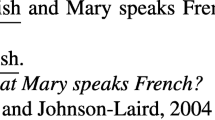Abstract
In a seminal work, Tversky and Kahneman showed that in some contexts people tend to believe that a conjunction of events (e.g., Linda is a bank teller and is active in the feminist movement) is more likely to occur than one of the conjuncts (e.g., Linda is a bank teller). This belief violates the conjunction rule in probability theory. Tversky and Kahneman called this phenomenon the “conjunction fallacy”. Since the discovery of the phenomenon in 1983, researchers in psychology and philosophy have engaged in important controversies around the conjunction fallacy. The goal of this paper is to explore the most important of these controversies, namely, the controversy about the nature of the conjunction fallacy. Is the conjunction fallacy mainly due to a misunderstanding of the problem by participants (misunderstanding hypothesis) or is it mainly due to a genuine reasoning bias (reasoning bias hypothesis)? A substantial portion of research on the topic has been directed to test the misunderstanding hypothesis. I review this literature and argue that a stronger case can be made against the misunderstanding hypothesis. Thus, I indirectly provide support for the reasoning bias hypothesis.
Similar content being viewed by others
References
Adler J. (1984) Abstraction is uncooperative. Journal for the Theory of Social Behaviour 14: 165–181. doi:10.1111/j.1468-5914.1984.tb00493.x.
Adler J. (1991) An optimist’s pessimism: Conversation and conjunction. Posnam Studies in the Philosophy of the Sciences and Humanities 21: 251–282
Agnoli F., Krantz D. (1989) Suppressing natural heuristic by formal instruction: The case of the conjunction fallacy. Cognitive Psychology 21: 515–550. doi:10.1016/0010-0285(89)90017-0.
Bar-Hillel M., Neter E. (1993) How alike is it versus how likely is it: A disjunction fallacy in probability judgments. Journal of Personality and Social Psychology 65(6): 1119–1131. doi:10.1037/0022-3514.65.6.1119.
Bonini N., Tentori K., Osherson D. (2004) A different conjunction fallacy. Mind & Language 19(2): 199–210. doi:10.1111/j.1468-0017.2004.00254.x.
Cohen L.J. (1977) The probable and the provable. Clarendon Press, Oxford
Cohen L.J. (1981) Can human irrationality be experimentally demonstrated?. The Behavioral and Brain Sciences 4: 317–370
Cohen L.J. (1982) Are people programmed to commit fallacies? Further thoughts about the interpretation of experimental data and probability judgment. Journal for the Theory of Social Behaviour 12: 251–274. doi:10.1111/j.1468-5914.1982.tb00450.x.
Dulany D., Hilton D. (1991) Conversational implicature, conscious representation and the conjunction fallacy. Social Cognition 9: 85–110
Fiedler K. (1988) The dependence of the conjunction fallacy on subtle linguistic factors. Psychological Research 50: 123–129. doi:10.1007/BF00309212.
Gigerenzer G. (1994) Why the distinction between single-event probabilities and frequencies is important for psychology (and vice versa). In: Wright G., Ayton P.(eds) Subjective probability. Wiley, New York, pp 129–161
Gigerenzer G. (1996) On narrow norms and vague heuristics: A reply to Kahneman and Tversky (1996). Psychological Review 103(3): 592–596. doi:10.1037/0033-295X.103.3.592.
Gilovich T., Griffin D., Kahneman D. (2002) Heuristics and biases: The psychology of intuitive judgment. Cambridge University Press, Cambridge
Grice H.P. (1975) Logic and conversation. In: Cole P., Morgan J.L.(eds) Sintax and semantics 3: Speech acts. Academic Press, New York, pp 41–58
Hastie R., Dawes R. (2001) Rational choice in an uncertain world: The psychology of judgment and decision making. Sage Publications, Thousand Oaks
Hertwig R., Chase V. (1998) Many reasons of just one: How response mode affects reasoning in the conjunction problem. Thinking & Reasoning 4(4): 319–352. doi:10.1080/135467898394102.
Hertwig R., Gigerenzer G. (1999) The conjunction fallacy revisited: How intelligent inferences look like reasoning errors. Journal of Behavioral Decision Making 12: 275–305. doi :10.1002/(SICI)1099-0771(199912)12:4<275::AID-BDM323>3.0.CO;2-M.
Hilton D. (1995) The social context of reasoning: Conversational inference and rational judgment. Psychological Bulletin 118(2): 248–271. doi:10.1037/0033-2909.118.2.248.
Inhelder B., Piaget J. (1964) The early growth of logic in the child: Classification and seriation. Norton, New York
Kahneman D., Tversky A. (1996) On the reality of cognitive illusions. Psychological Review 103(3): 592–591. doi:10.1037/0033-295X.103.3.582.
Macdonald R., Gilhooly K. (1990) More about Linda or conjunctions in contexts. The European Journal of Cognitive Psychology 2: 57–70. doi:10.1080/09541449008406197.
Messer W., Griggs R. (1993) Another look at Linda. Bulletin of the Psychonomic Society 31: 193–196
Morier D., Borgida E. (1984) The conjunction fallacy: A task specific phenomenon?. Personality and Social Psychology Bulletin 10: 243–252. doi:10.1177/0146167284102010.
Moro, R. (2007). Linda is back: Controversies around the conjunction fallacy in the psychology of reasoning. Dissertation, University of South Carolina.
Politzer G., Noveck I. (1991) Are conjunction rule violations the result of conversational rule violations?. Journal of Psycholinguistic Research 20: 83–103. doi:10.1007/BF01067877.
Samuels R., Stich S. (2004) Rationality and psychology. In: Mele A., Rawling P.(eds) The Oxford handbook of rationality. Oxford University Press, Oxford, pp 279–300
Samuels R., Stich S., Faucher L. (2002) Reason and rationality. In: Niiniluoto I., Sintonen M., Wolenski J.(eds) Handbook of epistemology. Kluwer, Dordrecht, pp 131–179
Shafer G. (1976) A mathematical theory of evidence. Princeton University Press, Princeton, NJ
Sides, A. (2000). The conjunction fallacy under probability and betting instructions. MA Thesis, Rice University.
Sides A., Osherson D., Bonini N., Viale R. (2002) On the reality of the conjunction fallacy. Memory & Cognition 30(2): 191–198
Tentori K., Bonini N., Osherson D. (2004) The conjunction fallacy: A misunderstanding about conjunction?. Cognitive Science 28: 467–477
Tversky A., Kahneman D. (1983) Extensional versus intuitive reasoning: The conjunction fallacy in probability judgment. Psychological Review 90(4): 293–315. doi:10.1037/0033-295X.90.4.293.
Wedell, D.H., & Moro, R. (2007). Testing boundary conditions for the conjunction fallacy: Effects of response mode, conceptual focus and problem type. Cognition (in press). doi:10.1016/j.cognition.2007.08.03.
Wolford G., Taylor H.A., Beck J.R. (1990) The conjunction fallacy?. Memory & Cognition 18: 47–53
Author information
Authors and Affiliations
Corresponding author
Rights and permissions
About this article
Cite this article
Moro, R. On the nature of the conjunction fallacy. Synthese 171, 1–24 (2009). https://doi.org/10.1007/s11229-008-9377-8
Received:
Accepted:
Published:
Issue Date:
DOI: https://doi.org/10.1007/s11229-008-9377-8




